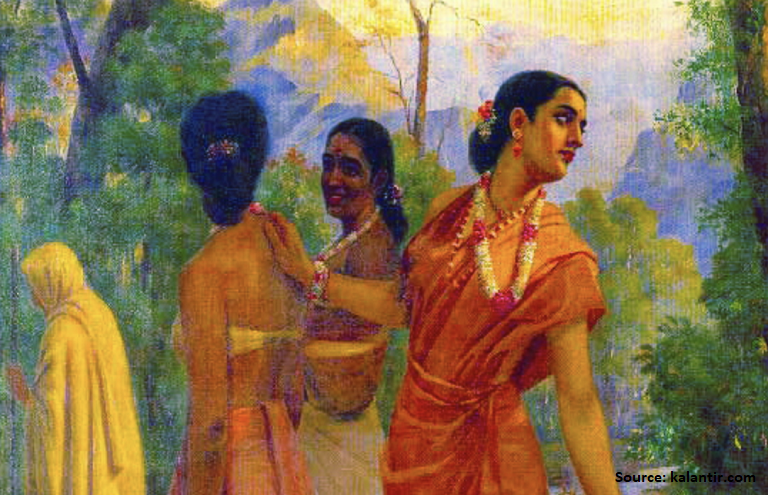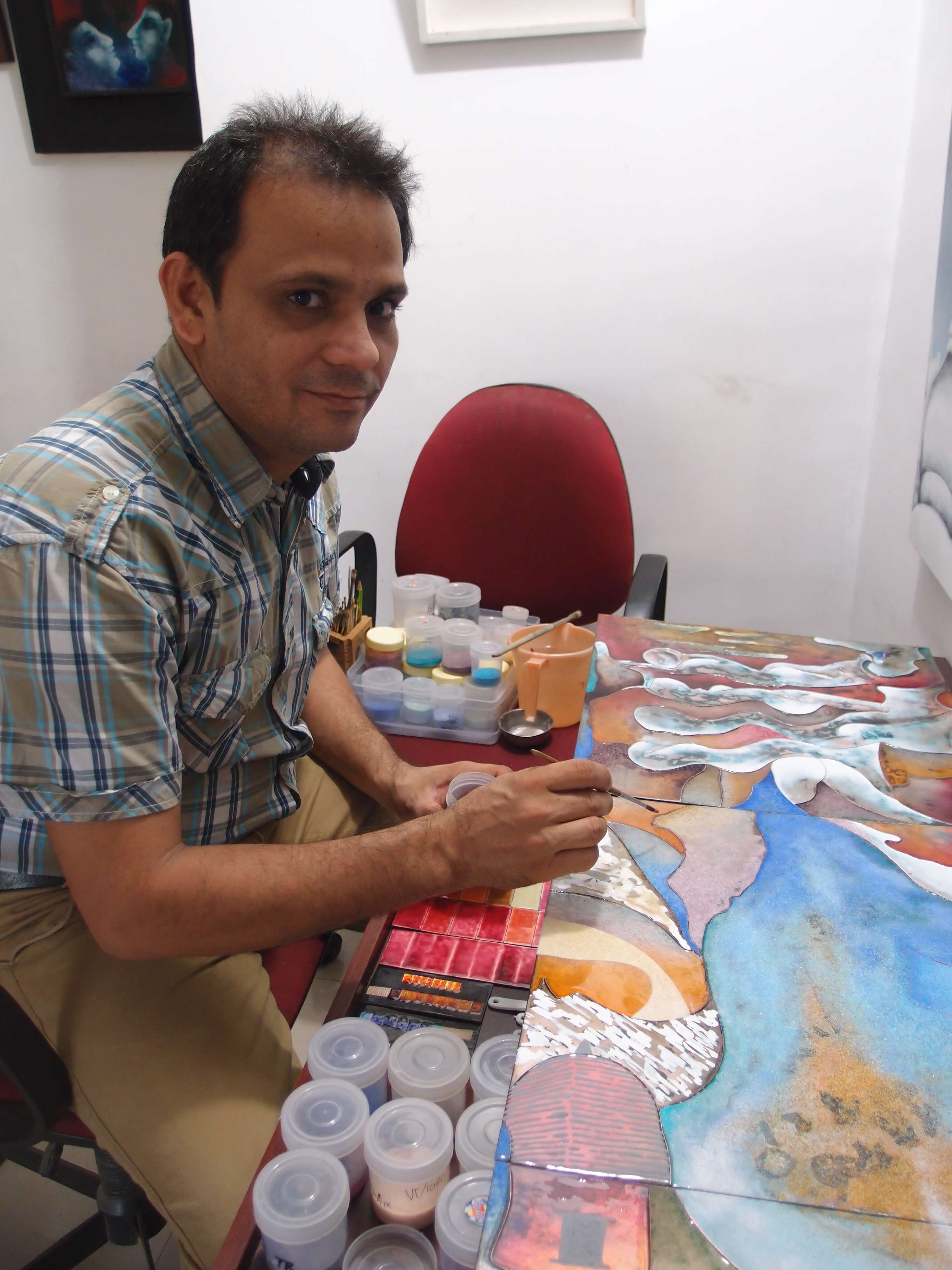
What is Oil Painting?
Have you ever been mesmerized by the idea of beautiful oil paintings hanging on your white and dull wall? It is a great idea to transform your boring corner into an energetic vibe and Instagram-friendly corner! With us, relive the idea of Indian Oil paintings in your lobby!
Oil paintings, in particular, are defined as art pieces where the painting is done in oil colors. Here, a medium, which consists of pigments, is suspended in dry oil. Some of the majorly used drying oils in the industry are linseed oil, poppy seed oil, safflower oil, etc.
The decision of oil grants scope of properties to the oil paint, like the measure of yellowing or drying time. The paint could be diminished with Turpentine. Certain distinctions, contingent upon the oil, are additionally noticeable in the sheen of the paints.
Indian Oil Paintings On Canvas- A Step By Step Guide!
Indian oil painting is an old-school cache because many of the European Renaissance artists used and popularised the same. This does not imply that oil pastel color paintings can are used for contemporary art. Artists should not feel intimidated by the same. Indian oil paints and paintings are said to be rich and versatile amongst other popular types.
5 Easy Steps To An Mesmerising Indian Oil Painting
Pro Tip: Oil Paints, which are usually made out of pigmented powder and oil take a longer period to dry up. They require a certain special kind of care while using and keeping it clean.
Step 1: Collect the correct materials
Below is the list of supplies that you would need while going forward with the oil painting on canvas:
-
Paint brushed- preferably hog hair or synthetic fibers
-
A variety of oil paints
-
Canvas to be used as a surface
-
Linseed oil or a solvent to thin the paints
-
Paint mixing palette along with a palette knife to mix the oil colors. Avoid using brushes for the same.
-
An old rug or tissue papers
-
Easel
When starting oil painting, start with only a couple of fundamental tones. This will permit you to test more with shading blending, which will give you a decent vibe for oil paints' characteristics. Start with the essential tones in addition to white and dark, and add others whenever you've dominated the oil painting rudiments. Starter sets give a decent reach to amateur oil painters.
Most quality paintbrushes will indicate whether they're reasonable for oil painting. Likewise, with paints, you can get a starter set or pick individual brushes. Accumulate a mix of round, square, and fan shapes in various sizes. Like with paints, it's a smart thought, to begin with, a more modest assortment, and afterward add to it whenever you've got an opportunity to test.
The best surface for oil painting is an extended material or material board. Whichever surface you pick, you should prepare it with gesso.
Step 2: Setting Up A Safe Space For You To Work
Some people feel that oil painting can not be done at a setup made in your very own house- this is right. Due to its toxic smells and harmful effect on health0 keeping away from your house is a good option to consider. You must find a spot outdoor or in a space full of ventilation. Experts also advise using nitrile gloves and latex while using oil paints- this should be done to avoid getting your skin in contact with dangerous chemicals.
Step 3: Priming of the Canvas
When starting oil painting, start with only a couple of fundamental tones. This will permit you to test more with shading blending, which will give you a decent vibe for oil paints' characteristics. Start with the essential tones in addition to white and dark, and add others whenever you've dominated the oil painting rudiments. Starter sets give a decent reach to amateur oil painters.
Most quality paintbrushes will indicate whether they're reasonable for oil painting. Likewise, with paints, you can get a starter set or pick individual brushes. Accumulate a mix of round, square, and fan shapes in various sizes. Like with paints, it's a smart thought, to begin with, a more modest assortment, and afterward add to it whenever you've got an opportunity to test.
The best surface for oil painting is an extended material or material board. Whichever surface you pick, you should prepare it with gesso
Step 4: Outlining the Painting
Once the canvas is ready to be painted, one of the most common practices that artists have is to cover the canvas in a thin wash that will act as the base for your painting. Post this, a rough sketch should be prepared as an outline for the painting. They sketch dominant shapes, focal points, and lines on the canvas with a light coat of black paint or even a pencil.
Post this, you are all set to pursue the mixing of oil paints for your oil painting on canvas. Add on the oil paints to color mixing particles- just like it would be done to other kinds of pigments. Reducing the thickness of your paint to get a variety of effects can be done using the solvents or oil into the paint tube.
Step 5: Start Layering Your Paints
After preparing your composition, you'll need to develop the paint and shading. One of the oil painting essentials is to follow the "fat over lean" rule. This keeps oil paint from breaking once dry (or setting aside a huge chunk of effort to dry in any case). The oilier the paint, the "fatter" it is, and the more it will take to dry. In this way, you'll generally need to apply less fatty (more slender) paints first, underneath the fatter (oilier) layers, to forestall breaking. What amount of time does oil paint require to dry? That relies upon how thick it is, yet it can require three months or more.
2 Famous Indian Oil Paintings
Oil painting in India is known to be one of the oldest painting techniques that include mixing of oil or dried oil with color pigments- creating a beautiful art piece. While it was initiated by the Indians and the Chinese in the 5th and 6th centuries, it was only in the 15th century that oil paintings got their due importance. Here, artists made sure to use a variety of materials to work on- but the most popular one was an oil painting on canvas.
Well, while we learn more about the oil paintings and oil pastel color paintings- available easily on the online oil painting gallery- let us focus on the mesmerizing Indian oil paintings that are famous worldwide!

-
Shakuntala is a famous Indian oil painting created by Raja Ravi Varma. This painting was produced in 1870- aiming to depict a lady named Shakuntala. She is seen removing a thorn from her foot; looking at her husband/ lover whilst hiding.
-
Towards Light is a solo depiction of Jehangir created by Vasant Raghunath Ambedkar. His oil artworks, aquarelles, and pastel drawings are enlivened by an exuberant vision and a fine feeling of perception that catch minutes loaded up with a supernatural, nebulous presence. Workmanship India gatherings were held from 1946 to 1949 which brought about the establishment of Lalit Kala Academy, Prof. Ambedkar was addressed as the leader of the Art Society of India with Shri. M. R. Achrekar, Shri. Manu Thacker, Dinesh Vora, and Mulkaj Anand from Bombay.
Oil Paintings On Canvas Without Solvents
The most common question that arises- epically by the oil painting freshers- is painting without solvents or any toxic medium possible! Well, the answer to that is yes! Further, while you continue reading and learning about oil paintings in India- we will also make sure to guide you best- keeping your studio safe for pets, kids, and of course- for yourself.
Why Use a Solvent-Free Paint?
At every step in life- your passion is what remains unchanged. Moving towards a solvent-free paint to ensure to carry on your passion along every step in life is a better and healthy way! Solvents or harmful chemicals used in various oil paints are a matter to worry about. They eventually affect you with allergies and breathing issues that may be untreated for life.
Here, we aim towards the ones who think twice to work and paint in oil due to its toxicity. We will make sure that you can do every ounce of oil painting without toxic and harmful solvents.
Steps To Match Your Agenda For A Solvent-Free Studio for Oil Painting
Pet and Child Proofing the Area
-
Make sure that nothing hazardous is lying around that is easily accessible to kids or pets.
-
Keep everything back in cupboards and drawers.
-
Follow the policy of ‘Out of mind, out of site’. Ensure that things are placed at a height where kids or your pets can’t reach.
Avoid and eat your oil paints
-
To the extent, I realize harmful paint shades are just hazardous whenever eaten, or on the other hand on the off chance that they get into the circulatory system using wounds.
-
They can't get consumed by the skin by just having a smear on your finger.
-
So having painted all-around your hands isn't rash however cleaning up completely before you rub your eye or eat your sandwich is fundamental.
Train your pet / to explain it to your toddle
-
Sound judgment is all overall quite great, however, a baby or a canine, by and large, has very little of it.
-
So it likely could be a smart thought to just boycott all paints that are considered poisonous.
-
You may be sufficiently reasonable to clean up, yet your child won't be. So stick to titanium white and cadmium options.
Options in contrast to Solvents and Other Toxic Materials
Harmful Paint Colors
A few paints are produced using harmful shades, for example, cadmium, cobalt, or lead. Regardless of whether a paint tone is poisonous isn't constantly expressed on the cylinder, so you may need to do some exploration.
Do remember that the poisonous bit isn't generally risky similarly. A few colors are risky to contact as they can get consumed through cuts and touches on the skin. For different colors, it is for the most part risky if the residue is taken in. Tubed oil paint doesn't have any residue so those colors are somewhat protected to use, as long as you don't eat the paint or crush your paint from the shade. All things considered, assuming you need to sand your canvas, for impact, or to get ready to cover up it, you are relaxing residue particles and should watch out. You will not drop dead the moment you breathe in a poisonous shade molecule, however, on the off chance that you do this routinely throughout an extensive period, it can hurt you.
For most harmful paints there are options out there. Rather than a cadmium red, you can purchase different various reds. Each brand will name them diversely so it is hard to give ideas. I utilize Mussini's Brilliant Scarlet, for instance, which is near a cadmium red light, or probably Vasari's Permanent Bright Red which is a bit more grounded. Most brands know that we need safe options in contrast to the harmful shades, and are fabricating an incredible scope of decisions. Post for cautioning signs and do your exploration.
Solvents
Oil painting without solvents isn't difficult to do, yet it requires a few changes. Solvents are effortlessly stayed away from. Numerous craftsmen feel that having a container of turps open close to their easel is a total should, however, nothing is further from reality. Of all oil painting materials, solvents are the most unsafe to your wellbeing as they have vapor that will fill the air in your room. Oil paint colors don't have exhaust, so you can't inhale it in. However, solvents do have poisonous exhaust and in this manner, it is prescribed to consistently keep the container shut. Assuming you need to boycott it by and large, as I have accomplished for quite a long time, there are a lot of alternatives.
Cleaning
Most specialists use solvents to clean their brushes. So what do you utilize assuming you need to keep away from solvents? Water and cleanser, for instance, functions admirably. Dishwashing fluid and water likewise functions admirably. Or probably use painting oil (linseed, pecan) to wipe out the paint, after which you wash the brush with water and a cleanser to eliminate the oil. There are likewise protected brush cleaning cleansers available, for example, Masters cleanser (which is the thing that I use). To clean my brushes while I am painting, I just wipe them on some kitchen roll and clean appropriately with Masters Soap subsequently.
Diminishing
Numerous specialists like to utilize solvents to thin their paint. Maybe in an underpainting, they might want to begin with slim washes of paint. One option in contrast to this is to utilize water-solvent paint in the underpainting stages. Another alternative is to utilize acrylic paint for underpainting (it is totally fine to apply acrylic paint first and go over it with oil paint. It isn't extraordinary to do it the alternate way round). It's anything but a smart thought to utilize oil as a diminishing specialist in an underpainting, as it would make the paint excessively sleek ('fat') and you may cross paths with the 'fat-over-lean' rule. Keeping the paint incline in the initial few layers is consistently reasonable.
I essentially use paint directly from the cylinder for the underpainting. Assuming I need a slight layer of paint, I essentially utilize a strong brush and daintily scour on the paint. I needn't bother with a dissolvable and I don't have issues with drying time as the paint is cleaned on so daintily it is dry in a matter of seconds and I can cover it essentially right away.
On the off chance that I feel like I need more slender paint in later layers, I add a non-poisonous medium like linseed oil to thin the paint (never more than around 20% blended in the paint, or simply a dribble!).
On the off chance that you need more liquid paint, you can likewise think about evolving brands. If you like slight paint (as I do) utilizing a brand that makes liquid paint is a decent beginning. I find, for instance, Old Holland very thick and pale, while Vasari and Blockx are more liquid.
Mediums
Most instant oil painting mediums have dissolvable in them. Do take a gander at the fixings, or on the other hand, in case they are not recorded on the jug, simply ask the producer or dealer what is in it. Many are glad to reply. A medium will change the typical conduct of oil paint. So you possibly need it assuming you need your paint to accomplish something that it doesn't regularly do. Like drying rapidly. Or then again being extremely liquid, or exceptionally thick (for impasto).
The best guidance I can offer is to simply keep it straightforward. You probably won't require a medium by any means. I by and large don't paint with a medium and use paint directly from the cylinder. You can attempt linseed oil or pecan oil to check whether it suits you however it may dial back drying time. Linseed and Walnut oil are not harmful. There are different oils available that do different things to your paint. However, they all make your paint 'fatter' so just utilize little sums.
Stain
I still can't seem to track down a non-harmful stain for oil works of art. All things considered, there is no standard that you HAVE to stain your work. A few craftsmen do and a few specialists don't. Staining offers the best security I can give and a stain will essentially add an engineered layer between the paint and the rest of the world.
If residue or grime gets onto the artwork, it lands on the stain and not the paint. If it gets a perfect or a light residue, it is the stain you are cleaning, not the paint. I track down this as a consoling idea thus I do stain. Staining happens when the children are out, with the entryway/windows open. A lot of specialists, notwithstanding, don't stain. They don't care for its vibe (even though there is matt/silk/sparkle stain out there) or adding a layer to their paint. We are trusting that a maker will concoct a dissolvable free stain.
Read More: Basic Techniques for Oil Pastel Colour Painting
Wrap up:
While fetching the best relevant information about oil paintings- holding on to the mesmerizing beauty of Oil paintings on campus is a must. While you look into the idea of Oil painting- make sure to get your hands on the best ones - only on an online oil painting gallery.
With such professionals- you can get oil pastel art and oil paintings for your living room. Let your house speak for you with the help of such paintings and art pieces. Order in for some amazing artwork at affordable prices with Indian Art Ideas. Order in for some amazing experiences this season!
While there are emerging artists all around the globe- catch upon the work of Indian oil painting professionals!





















